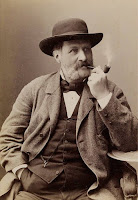For centuries, pipe smoking has been a symbol of leisure, contemplation, and camaraderie. From the grand halls of European aristocrats to the rugged landscapes of the American frontier, the humble tobacco pipe has evolved in materials, craftsmanship, and style. What began as simple clay and wooden designs has transformed into an art form, with artisans around the world crafting pipes from exotic woods, metals, and even meerschaum.
Today, we’ll take a journey through time and explore the evolution of the tobacco pipe—from its ancient origins to the refined briar masterpieces of today.
1. The Early Days: Native Clay and Wood Pipes
Long before tobacco was introduced to Europe, Indigenous cultures across North and South America were already cultivating and smoking it for ceremonial and medicinal purposes.
Native American Pipes
- The earliest known pipes date back over 3,000 years, with some of the most famous examples coming from the Hopewell and Mississippian cultures.
- Native American tribes crafted calumets, or peace pipes, from stone or pipestone (catlinite), often elaborately carved and used in rituals, diplomacy, and prayer.
- Some groups used wooden pipes, with hollowed-out stems and bowls made from different regional materials.
When European explorers arrived in the New World, they were introduced to the practice of smoking tobacco, quickly adopting it and spreading the habit across the globe.
2. The Rise of the Clay Pipe (16th-19th Century)
As tobacco became widely popular in Europe in the 16th century, so did the clay pipe. With simple yet elegant designs, these pipes became the primary smoking instrument for centuries.
Why Clay?
- Easily available and cheap to produce.
- Porous nature allowed for a cool, dry smoke.
- Simple to shape and mass-produce, making them affordable for all social classes.
By the 17th and 18th centuries, clay pipes became a status symbol, with long, delicate stems preferred by the upper class. Many taverns and public houses offered communal clay pipes that patrons would break off after each use.
Notable Clay Pipe Designs
- Tavern Pipes – Long-stemmed and elegant, used in pubs.
- Cutty Pipes – Shorter and more practical, often used by sailors and working-class smokers.
- Dutch Gouda Pipes – Extra-long-stemmed pipes with intricate designs, favored in the Netherlands.
Clay pipes dominated until the 19th century, when a new material revolutionized pipe making: meerschaum.
3. Meerschaum: The Carved Masterpieces (18th-19th Century)
As pipe smoking became more refined, a new luxury material emerged: meerschaum.
What is Meerschaum?
- A rare, lightweight mineral (hydrated magnesium silicate) found mainly in Turkey.
- Carves easily, allowing for intricate, artistic designs.
- Absorbs tobacco oils, darkening over time into a rich golden hue.
Why Meerschaum Became Popular
- Unlike clay, it didn’t heat up as much, making it more comfortable to hold.
- The elaborate carvings (faces, animals, mythological figures) became status symbols.
- Many meerschaum pipes were fitted with amber stems, adding to their elegance.
Meerschaum pipes dominated high society smoking until briar wood made its debut.
4. The Briar Revolution (Mid-19th Century – Present)
By the mid-1800s, another material took over the world of pipe smoking: briar wood.
What is Briar?
- Comes from the root burl of the Mediterranean heath tree (Erica arborea).
- Naturally heat-resistant and durable.
- Absorbs moisture, resulting in a cooler, drier smoke.
Why Briar Took Over
Briar pipes were lighter, stronger, and more resilient than meerschaum or clay. They could also be mass-produced or carved into custom, handcrafted pieces, leading to the explosion of pipe making as an art form.
Classic Briar Pipe Shapes
- Billiard – The most classic, straight-stemmed pipe.
- Bulldog – A stout, diamond-shanked design.
- Bent Dublin – A curved, elegant shape for easy clenching.
- Churchwarden – Extra-long stem, made famous by Tolkien’s characters.
With the rise of briar, pipe makers across the world—Dunhill in England, Peterson in Ireland, and Savinelli in Italy—created brands that still dominate the market today.
5. 20th Century Innovations: Materials Beyond Briar
Although briar remains the gold standard, the 20th century saw experimentation with new materials:
Corn Cob Pipes (America’s Contribution)
- Affordable and lightweight, made famous by Missouri Meerschaum.
- The pipe of choice for Mark Twain and General Douglas MacArthur.
- Burns surprisingly cool and remains a favorite among budget-conscious smokers.
Metal Pipes (1960s-1970s)
- The Falcon pipe featured a metal body with interchangeable briar bowls.
- Designed to be easier to clean and provide a drier smoke.
- Became a novelty but never overtook traditional briar.
Exotic Woods & Alternative Materials
- Olivewood, morta (bog oak), and cherrywood emerged as briar alternatives.
- Carbon fiber and acrylic stems provided modern durability.
- Handcrafted Freehand pipes became popular with Danish artisans like Sixten Ivarsson.
6. Modern Era: A Renaissance in Pipe Making
Today, pipe smoking is enjoying a renaissance, blending tradition with innovation.
What’s Trending Now?
✔️ Handmade Artisan Pipes – Collectors seek one-of-a-kind pipes from carvers like Jody Davis, Adam Davidson, and Jeff Gracik.
✔️ High-End Meerschaum Pipes – Turkey’s master carvers continue to create exquisite, museum-quality pieces.
✔️ Sustainable Wood Choices – Morta and olivewood are growing in popularity.
✔️ Technology & Pipe Smoking – Filters, hybrid materials, and even 3D-printed pipes are emerging.
Despite changes in technology and materials, the ritual and relaxation of pipe smoking remain timeless.
Final Thoughts: A Tradition That Endures
From the ancient pipes of Native Americans to the briar masterpieces of today, the evolution of the tobacco pipe tells the story of culture, craftsmanship, and tradition. Whether you prefer the history of clay pipes, the artistry of meerschaum, or the reliability of briar, there’s a pipe for every smoker.
What’s your favorite type of pipe? Are you a briar purist, a meerschaum enthusiast, or a cob-lover? Drop your thoughts in the comments below!
🔥 Happy puffing and long live the tradition of the pipe! 🔥
























No comments:
Post a Comment